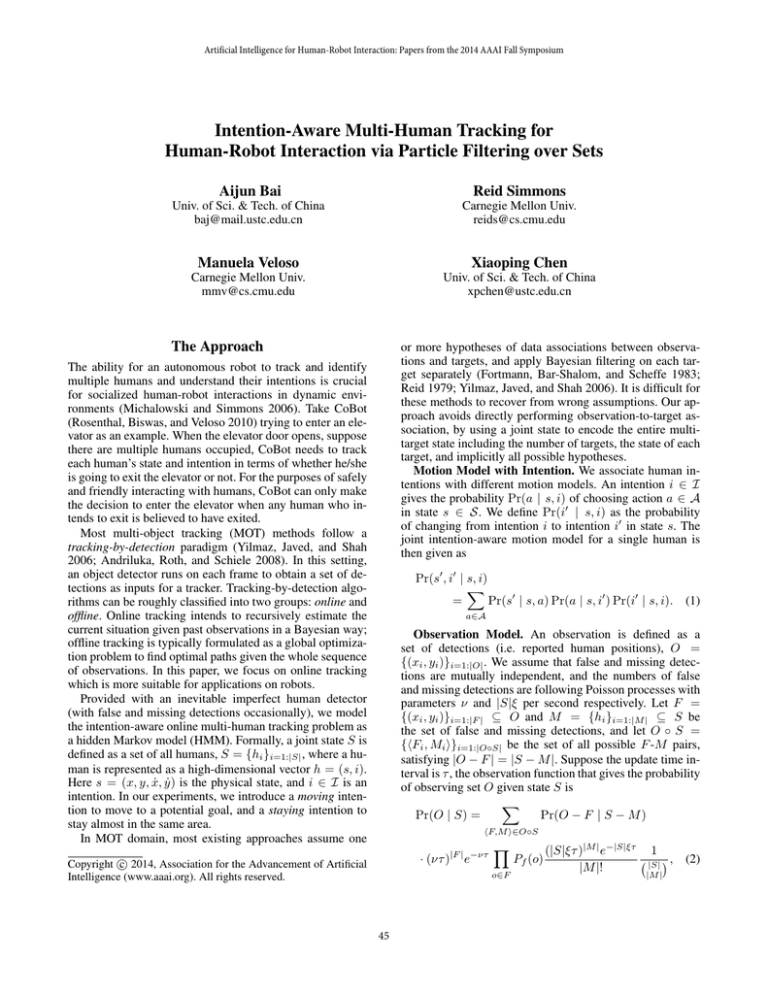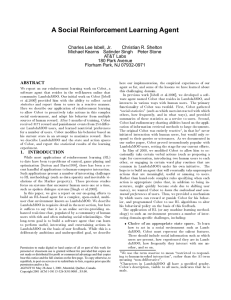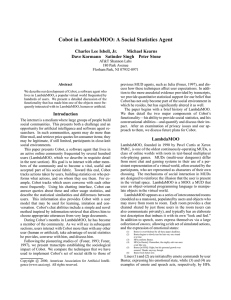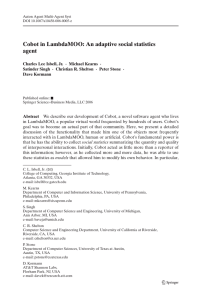
Artificial Intelligence for Human-Robot Interaction: Papers from the 2014 AAAI Fall Symposium
Intention-Aware Multi-Human Tracking for
Human-Robot Interaction via Particle Filtering over Sets
Aijun Bai
Reid Simmons
Univ. of Sci. & Tech. of China
baj@mail.ustc.edu.cn
Carnegie Mellon Univ.
reids@cs.cmu.edu
Manuela Veloso
Xiaoping Chen
Carnegie Mellon Univ.
mmv@cs.cmu.edu
Univ. of Sci. & Tech. of China
xpchen@ustc.edu.cn
The Approach
or more hypotheses of data associations between observations and targets, and apply Bayesian filtering on each target separately (Fortmann, Bar-Shalom, and Scheffe 1983;
Reid 1979; Yilmaz, Javed, and Shah 2006). It is difficult for
these methods to recover from wrong assumptions. Our approach avoids directly performing observation-to-target association, by using a joint state to encode the entire multitarget state including the number of targets, the state of each
target, and implicitly all possible hypotheses.
Motion Model with Intention. We associate human intentions with different motion models. An intention i ∈ I
gives the probability Pr(a | s, i) of choosing action a ∈ A
in state s ∈ S. We define Pr(i0 | s, i) as the probability
of changing from intention i to intention i0 in state s. The
joint intention-aware motion model for a single human is
then given as
The ability for an autonomous robot to track and identify
multiple humans and understand their intentions is crucial
for socialized human-robot interactions in dynamic environments (Michalowski and Simmons 2006). Take CoBot
(Rosenthal, Biswas, and Veloso 2010) trying to enter an elevator as an example. When the elevator door opens, suppose
there are multiple humans occupied, CoBot needs to track
each human’s state and intention in terms of whether he/she
is going to exit the elevator or not. For the purposes of safely
and friendly interacting with humans, CoBot can only make
the decision to enter the elevator when any human who intends to exit is believed to have exited.
Most multi-object tracking (MOT) methods follow a
tracking-by-detection paradigm (Yilmaz, Javed, and Shah
2006; Andriluka, Roth, and Schiele 2008). In this setting,
an object detector runs on each frame to obtain a set of detections as inputs for a tracker. Tracking-by-detection algorithms can be roughly classified into two groups: online and
offline. Online tracking intends to recursively estimate the
current situation given past observations in a Bayesian way;
offline tracking is typically formulated as a global optimization problem to find optimal paths given the whole sequence
of observations. In this paper, we focus on online tracking
which is more suitable for applications on robots.
Provided with an inevitable imperfect human detector
(with false and missing detections occasionally), we model
the intention-aware online multi-human tracking problem as
a hidden Markov model (HMM). Formally, a joint state S is
defined as a set of all humans, S = {hi }i=1:|S| , where a human is represented as a high-dimensional vector h = (s, i).
Here s = (x, y, ẋ, ẏ) is the physical state, and i ∈ I is an
intention. In our experiments, we introduce a moving intention to move to a potential goal, and a staying intention to
stay almost in the same area.
In MOT domain, most existing approaches assume one
Pr(s0 , i0 | s, i)
X
=
Pr(s0 | s, a) Pr(a | s, i0 ) Pr(i0 | s, i). (1)
a∈A
Observation Model. An observation is defined as a
set of detections (i.e. reported human positions), O =
{(xi , yi )}i=1:|O| . We assume that false and missing detections are mutually independent, and the numbers of false
and missing detections are following Poisson processes with
parameters ν and |S|ξ per second respectively. Let F =
{(xi , yi )}i=1:|F | ⊆ O and M = {hi }i=1:|M | ⊆ S be
the set of false and missing detections, and let O ◦ S =
{hFi , Mi i}i=1:|O◦S| be the set of all possible F -M pairs,
satisfying |O − F | = |S − M |. Suppose the update time interval is τ , the observation function that gives the probability
of observing set O given state S is
X
Pr(O | S) =
Pr(O − F | S − M )
hF,M i∈O◦S
· (ντ )|F | e−ντ
c 2014, Association for the Advancement of Artificial
Copyright Intelligence (www.aaai.org). All rights reserved.
Y
o∈F
45
Pf (o)
(|S|ξτ )|M | e−|S|ξτ
|M |!
1
, (2)
|S|
|M |
where Pf is a background distribution stating that a false
detection occurring in position o = (x, y) has a probability
density of Pf (o). Notice that, the probability density Pr(O |
S) is defined over sets.
Let ΨO−F
S−M be the set of all possible assignments from
S − M to O − F , and assume conditional independence
between observations, we have
X
Y
Pr(O − F | S − M ) =
Po (ψ(h) | h), (3)
ψ∈ΨO−F
S−M
Algorithm
1
PFS (proposed)
PFS12 (proposed)
Milan (2014)
Segal and Reid (2013)
Segal and Reid2 (2013)
Zamir, Dehghan, and Shah2 (2012)
Breitenstein et al.2 (2011)
1
2
h∈S−M
MOTA
MOTP
IDS
0.93
0.91
0.90
0.92
0.90
0.90
0.56
0.76
0.75
0.80
0.75
0.75
0.69
0.80
3.6
4.8
11
4
6
8
-
averaged over 16 runs.
evaluated within tracking region not cropped.
Table 1: Results in PETS2009 S2L1 dataset.
where Po (o | h) gives the probability density of observing o
given human state h. The resulting full expression of Equation 2 has Ω(( max{|O|,|S|}
)min{|O|,|S|} ) terms. Approximae
tions are made in practice.
Particle Filtering. To infer in the resulting HMM,
we propose a probabilistic approach named particle filtering over sets (PFS), which avoids directly performing
observation-to-target association by using a set as a joint
state to encode the entire multi-human state.
Particle Refinement. For particle X, let X̃ be the directly
proposed particle based on motion model. For observation
o ∈ O, if it does not match well with existing humans in X̃,
then a refined proposal X̂ ← X̃ ∪ h, where h ∼ Pr(· | o),
will probably result a better proposal in terms of o. The proposal and motion weights are then approximated by using a
Bayesian density estimation method developed for sets.
Human Identification. Although a set of updated particles encodes completely the joint posterior distribution,
a human identification process is developed to report each
individual human from updated particles, which is more
useful for high-level tasks. We perform data associations
within each particle, link human states to observations, reduce the problem to a linear number of best assignment
sub-problems, and repeat this process until converged or
a maximal number of steps is reached in an expectationmaximization (EM) way.
Figure 1: A snapshot of running PFS.
greedy data association in a particle filtering framework.1
We conduct the real robot experiments on CoBot, by deploying the robot to be tasked by users in a university building (Biswas and Veloso 2013). A short video showing the
running PFS taken from one deployment can be found via
http://goo.gl/K70inP (13.7MB). A snapshot is also shown
in Figure 1. The robot is depicted by a yellow circle labeled with “Robot”. Observations from the human detector are represented as yellow circles labeled with sequential
numbers, for example “O:0”. Each identified human is illustrated as a circle for the current state and linked points for
respective trajectory. Dominant intentions associated with
states and trajectories are shown with different colors: cyan
for moving intention and orange for staying intention. Black
means no dominant intention classified yet.2
Experiments
To compare with existing MOT algorithms, we evaluate PFS
with only a random-walk motion model in the S2L1 sequence of the challenging PETS2009 dataset (Ferryman and
Shahrokni 2009). The experimental results are shown in Table 1, evaluated in terms of CLEAR MOT metrics with distance threshold of 1.0m (Bernardin and Stiefelhagen 2008).
We also report IDS which is the number of identity switches.
Only identified humans with confidence higher than 0.4 are
considered for evaluation. Segal and Reid (2013) model
MOT as a Switch Linear Dynamical System and take advantage of a trained pedestrian and outlier detector in the
target PETS dataset. Zamir, Dehghan, and Shah (2012) utilize Generalized Minimum Clique Graphs to solve the data
association problem by incorporating both motion and appearance information. Milan (2014) formulate MOT as an
optimization problem over splines given an energy function.
Breitenstein et al. (2011) track each human separately with
1
A short video showing the whole results compared with
ground truth is available at http://goo.gl/35UOy1.
2
A video showing CoBot following a human for approximately
10 minutes based on the results provided by PFS can also be found
at http://goo.gl/T3UtlS.
46
Conclusion
Conference on Autonomous Agents and Multiagent Systems:
volume 1-Volume 1, 915–922. International Foundation for
Autonomous Agents and Multiagent Systems.
Segal, A. V., and Reid, I. 2013. Latent data association:
Bayesian model selection for multi-target tracking. In Computer Vision (ICCV), 2013 IEEE International Conference
on, 2904–2911. IEEE.
Yilmaz, A.; Javed, O.; and Shah, M. 2006. Object tracking:
A survey. Acm computing surveys (CSUR) 38(4):13.
Zamir, A. R.; Dehghan, A.; and Shah, M. 2012. Gmcptracker: Global multi-object tracking using generalized minimum clique graphs. In Computer Vision–ECCV 2012.
Springer. 343–356.
We present a novel particle filtering over sets (PFS) approach to the intention-aware multi-human tracking problem in the domain of human-robot interaction. From a multiobject tracking point of view, our approach avoids directly
performing observation-to-target association by using a set
formulation. The experiments in PETS2009 dataset show
that the overall tracking performance is robust. The real
robot experiments indicate that a robot integrated with this
approach is able to track humans, and understand their intentions in terms of moving and staying. In future work, we
plan to apply PFS in complex social tasks with multiple intentions.
Acknowledgments
This work is supported in part by the National Hi-Tech
Project of China under grant 2008AA01Z150 and the Natural Science Foundation of China under grant 60745002 and
61175057. The authors want to thank Joydeep Biswas and
Brian Coltin for their help on setting up CoBot.
References
Andriluka, M.; Roth, S.; and Schiele, B. 2008. Peopletracking-by-detection and people-detection-by-tracking. In
Computer Vision and Pattern Recognition, 2008. CVPR
2008. IEEE Conference on, 1–8. IEEE.
Bernardin, K., and Stiefelhagen, R. 2008. Evaluating multiple object tracking performance: the CLEAR MOT metrics.
EURASIP Journal on Image and Video Processing 2008.
Biswas, J., and Veloso, M. M. 2013. Localization and navigation of the cobots over long-term deployments. The International Journal of Robotics Research 32(14):1679–1694.
Breitenstein, M. D.; Reichlin, F.; Leibe, B.; Koller-Meier,
E.; and Van Gool, L. 2011. Online multiperson trackingby-detection from a single, uncalibrated camera. IEEE
Transactions on Pattern Analysis and Machine Intelligence
33(9):1820–1833.
Ferryman, J., and Shahrokni, A. 2009. PETS2009: Dataset
and challenge. In 2009 Twelfth IEEE International Workshop on Performance Evaluation of Tracking and Surveillance (PETS-Winter), 1–6. IEEE.
Fortmann, T. E.; Bar-Shalom, Y.; and Scheffe, M. 1983.
Sonar tracking of multiple targets using joint probabilistic
data association. Oceanic Engineering, IEEE Journal of
8(3):173–184.
Michalowski, M. P., and Simmons, R. 2006. Multimodal
person tracking and attention classification. In Proceedings
of the 1st ACM SIGCHI/SIGART conference on Humanrobot interaction, 347–358. ACM.
Milan, A. 2014. Energy Minimization for Multiple Object
Tracking. PhD, TU Darmstadt, Darmstadt.
Reid, D. B. 1979. An algorithm for tracking multiple targets.
Automatic Control, IEEE Transactions on 24(6):843–854.
Rosenthal, S.; Biswas, J.; and Veloso, M. 2010. An effective personal mobile robot agent through symbiotic humanrobot interaction. In Proceedings of the 9th International
47




